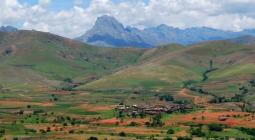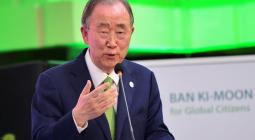Aid agencies grapple with climate adaptation in fragile states
Humanitarian groups have pushed ahead with innovative efforts to protect people in conflict zones from worsening climate impacts – but they are struggling to go it alone
Since its last major famine more than a decade ago, Somalia has received well over a billion dollars a year in humanitarian aid. But that spending – aimed at meeting immediate basic needs for food and water in the conflict-ravaged Horn of Africa country – has not reduced demands for help, which are instead rising as climate change brings more frequent and severe floods and droughts.
With supplies of international aid increasingly falling short around the world as the number and scale of crises and disasters grows, humanitarian groups are trying out new approaches to close the gap, including “anticipatory action” which pushes small amounts of cash to those in the path of a looming disaster, to help them better protect themselves and their assets.
In countries such as Bangladesh, with strong early warning systems and disaster-reduction mechanisms in place, such efforts have been shown to cut losses by about $7 for each $1 invested. But in the world’s most fragile and conflict-affected states – from Somalia to Afghanistan, and Iraq to Chad – systems like this are often missing.
Reducing humanitarian needs and boosting resilience there will require building basic infrastructure, something that can only happen if development, peace-building and relief groups – and their funders – get out of their comfort zones and overcome obstacles to working together, resilience researchers say.
“The only way to get ahead of a disaster is not by mitigating its effects but by avoiding it happening in the first place – by investing in disaster-risk reduction and climate adaptation,” said Mauricio Vazquez, who leads work on climate change and conflict at ODI Global, a London-based think-tank.
“You don’t need to wait for a bad weather forecast to do something. Anticipatory action done by humanitarians doesn’t create opportunities for people, it just helps make the best of a situation,” he said in an interview with Climate Home.
Weak governance exposes people
Abdihakim Ainte, director of climate change for Somalia’s prime minister, agreed that “vulnerability primarily stems from the dysfunction of key institutions.”
“The weaker the institutions, the more susceptible people are to every shock and disruption,” he told Climate Home.
At last year’s COP28 climate talks, more than 100 countries, banks and other organisations issued a call for “collective action to build climate resilience at the scale and speed required in highly vulnerable countries and communities, particularly those threatened or affected by fragility or conflict.”
Innovative efforts to make that happen are ramping up. Financiers including the African Development Bank, for instance, are increasingly trying to move development cash through peace-building and humanitarian groups on the ground in conflict-hit areas.
The bank has signed an agreement with the International Committee of the Red Cross (ICRC), an organisation that “has the ability to operate in very insecure environments. They stay there – they’ve been there for decades,” said Frederik Teufel, the bank’s lead coordinator of efforts to boost its investments in fragile contexts.
The ICRC focuses on using humanitarian grants to deliver short-term aid. But in places like conflict-plagued Goma, in the eastern Democratic Republic of Congo, or in Somalia, “there’s no reason they cannot use that delivery capacity there to also advance irrigation (or) community-based solar,” Teufel said in an interview with Climate Home.
Humanitarian groups can give funders crucial and otherwise unavailable insights into what communities affected by conflict themselves see as the most useful investments, he said, noting that “they all want development solutions, not another bag of rice.”
But significant institutional obstacles stand in the way of scaling up such cooperation, including a need by humanitarian groups to be seen as neutral in conflict zones, and accounting rules that require different types of development and climate funding to be kept in separate pots to avoid double counting.
Humanitarian action limited
In Goma, in the Democratic Republic of Congo, the ICRC, which focuses on protecting victims of armed conflict, is working with development partners and funders over seven years to rehabilitate and expand the Goma West water system – a project that serves both development and humanitarian needs.
But such projects don’t lead to meeting broad country-level needs, warned Catherine-Lune Grayson, head of policy at the ICRC.
In order to protect their ability to access conflict-hit communities, humanitarian groups need to carefully avoid taking sides in political disputes – and choices about partners and where to spend development money are often political.
“We have to tread a fine line. Where do we join forces, and where do we need to keep a healthy distance so it’s not read as too political?” Grayson asked, emphasising the need for “complementary” rather than “joint” work.
Scale is another issue. “We can help rehabilitate the water system in Goma, but you cannot ask the ICRC to restore and expand all water systems across the country. We will say we’re not equipped to do this,” she said.
Still, the view that countries struggling with conflict are not the sole responsibility of humanitarian agencies is fortunately growing, she said.
“A few years ago, there would not even have been a discussion about this. There’s been a real shift,” she added.
Maladaptation?
The different time horizons of humanitarian groups – focused on meeting short-term needs – and development actors – focused on longer-term aims – are another area that needs attention as groups try to work together, said Manisha Gulati, a global risks and resilience researcher with ODI Global.
In Somalia, for instance, wells and water storage are often being built to meet immediate humanitarian demand – but analysis by ODI researchers suggests the money is not being spent where it will be most needed in the future, as climate change impacts strengthen, she said.
“We have mapped where water insecurity is now and where it will get worse – and that’s where we should be thinking about. That’s how we prevent the next drought and humanitarian crisis,” Gulati said.
Today “we’re digging wells that won’t work in the long term. It’s maladaptation and we’re not using finance well if we’re using it in a manner where in the next 5-10 years we create a problem,” she said.
Simply improving communication among those working to solve problems in armed conflict areas is one way to move ahead, Gulati said. “How do we talk about collective action when agencies have no idea what the others are doing?” she asked.
Ainte, of Somalia, said efforts to win resources for crucial development in conflict-hit countries – a challenge as development aid stagnates – can often come into conflict with appeals for humanitarian aid, which keep the focus on vulnerability.
“The humanitarian narrative has to change to a development narrative. Somalia has resources that need to be invested in. We need that kind of mentality, that we are a country that has potential and deserves investment, rather than a country that has a problem,” he said.
Need to fix systems
But winning funding to boost development and create resilient systems in fragile countries will also require the countries themselves to step up, including cutting corruption and building stronger guardrails to ensure funds are used effectively, Gulati said.
“They need to understand it’s not a one-way street – they have to make an equal effort and adjustments,” she said. “You might get $100 million – but you won’t get more unless you fix the basics in your systems.”
With climate impacts surging and almost two-thirds of the world’s extreme poor expected to live in countries that are fragile or conflict-affected by 2030, the stakes for getting this cooperation right are growing, she added.
“We can keep throwing money at the humanitarian problem, but we’re not reducing the caseload,” she said. “We need to address the basic vulnerabilities that are leading to this situation. If we don’t do that, we’re not going to solve the problem.”
Cover photo: A child walks outside makeshift shelters at the Kaxareey camp for internally displaced people after they fled from severe drought, in Dollow, Gedo Region, Somalia, May 24, 2022. (REUTERS/Feisal Omar)




